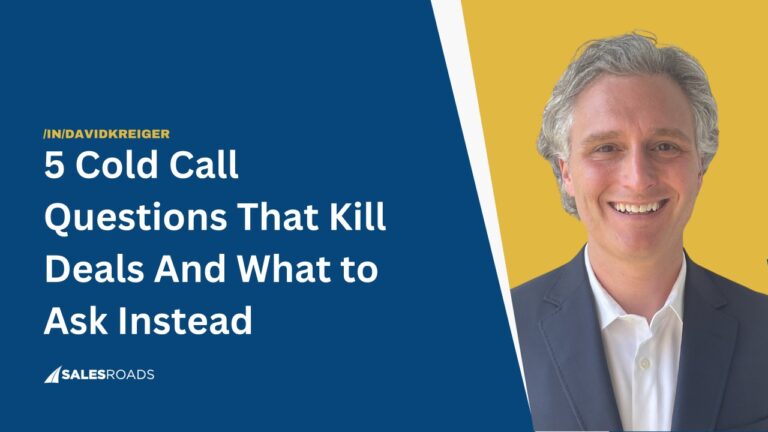Eight in every ten cold calls end up in voicemail. With PhoneBurner reporting more than 24 million voicemails recorded in 2021, this emphasizes the golden opportunity lying in unanswered cold calls to maximize your lead generation efforts.1
Voicemails are an extra touch point in the outreach process, providing a bridge to connect with decision-makers and potentially secure a callback. These individuals may not always answer their phones, but they frequently listen to their voicemails.
A voicemail, coupled with a missed call notification, can induce a sense of obligation in the prospect and encourage them to return your call. On average, salespeople reach out eight times before engaging a lead.2 However, integrating voicemails as a supplementary channel could reduce the number of touch points required to close a deal.
Tips For Cold Calling Voicemails That Incite Action
Prepare to leave a voicemail before you call
Given the high likelihood (80%) of hearing that voicemail beep on a cold call, it’s wise for salespeople to ready their voicemail script in advance. Being prepared will allow you to remain composed and record a clear, professional message if your call goes unanswered.
Speak with a relaxed tone
Even the sound of your voice can influence the effectiveness of your voicemail. A monotone or robotic voice can dissuade a prospect from following up. Instead, your tone should be calm, approachable, and professional to dispel any suspicion that you’re reading from a script.
Stay upbeat but not overly excited and communicate in a natural tone, regulating your cadence to ensure your message resonates with the lead. If you notice your voice sounding weary and monotone after numerous calls, take a brief break to rest and regain your energy before resuming your outreach.
Avoid rambling
The primary goal of a cold call voicemail is to secure a callback, and sharing unnecessary details may hinder that objective. Craft a message that compels a follow-up and remains focused on the point of your call.
Also, avoid using filler words like “uhm” and “uh,” as they sound rambling and undercut the authority of your message.
Leave a voicemail for every unanswered call
Callback rates from voicemail tend to increase with each message left for a potential customer, and a single one might not be sufficient to win their attention. Salespeople should therefore be comfortable leaving messages every time a call goes unanswered.
Redial the prospect every few days and leave a voicemail after each attempt. Maintain the same degree of urgency to convey the value of your proposal. If you leave three voicemails in one week and still receive no response, consider adopting a different outreach strategy.
State your phone number
Clearly and audibly share your contact information to ensure the prospect can follow up easily. Underscoring the strategic nuances of prospecting, two of our experts weighed in on dropping your number in a cold call voicemail:
- Robert Weese, sales and business communications advisor at Spark Centre, recommends leaving your number on a voicemail because it gives legitimacy to the call and boosts callbacks. He highlighted a common issue with phone services often labeling voicemails from unrecognized numbers as “unknown” to emphasize the importance of this seemingly minor detail.
- On the contrary, Sebastian Jania, a real estate expert, discourages leaving phone numbers on voicemails due to concerns that leads may reverse engineer the number and block subsequent calls. He also pointed out that disclosing contact details via voicemail identifies the caller as a salesperson rather than a familiar connection, which could deter a callback.
Don’t pitch
Cold call voicemails are not the venue for selling your product or service. Further, coming across as salesy in your message could diminish your chances of earning a callback.
Launching into a pitch strips the mystery off your initial call and dampens the potential customer’s eagerness to speak with you. Spark their interest first, and opportunities to present your product or service will naturally arise.
Be concise
Many decision-makers won’t invest more than 30 seconds listening to a voicemail. Therefore, your message should omit lengthy product descriptions and pitches and instead focus on the reason for your call.
Keeping your voicemail under 30 seconds increases the likelihood that the prospect will remain engaged and catch your contact information, which is typically shared at the end. This brevity also leaves room for curiosity, prompting the listener to imagine what’s left unsaid and spurring their interest to follow up.
Avoid buzzwords
While cold call voicemails should instill a sense of mystery and importance, avoid exaggerating your claims. Decision-makers can usually see through desperate attempts to draw them into a conversation. Resist the temptation to generate interest with promises of special offers, guarantees, or discounts.
Create urgency
Your cold call outreach is targeted at busy individuals who must prioritize their time. To convey your worthiness, your messages should induce urgency to compel prospects to contact you immediately.
Test your voicemails
Employ different voicemails in your outreach to identify which ones work best, then fine-tune those scripts to create a powerful communication strategy for your business.
Below are a few script samples to inspire your own. They’re designed to engage a prospect’s psychology by generating urgency or curiosity, triggering the fear of missing out (FOMO), or capitalizing on other emotional phenomena. Monitor the callback rates for each script to determine which are the most effective and adjust your cold-calling strategy accordingly for best results.
Elements Of A Winning Cold Call Voicemail Script
A compelling voicemail script must contain certain key elements to encourage the lead to return your call. These include:
- Name and company: Start your voicemail by introducing yourself. This personal touch makes your call more memorable. While some scripts may withhold company details to pique interest, your name is a must.
- Reason for calling: Quickly capture the prospect’s attention by briefly explaining why you’ve called. However, this might not always be necessary (as the Mystery sample script below demonstrates).
- Contact information: Like your name, contact details such as your phone number or email address are crucial to drop so the lead can reach you. Some salespeople prefer to state their contact information at the start and end of the call so it sticks in people’s memories.
- Call to action: Each cold call voicemail should contain a clear call to action that outlines specific next steps for the prospect to take.
Sample Voicemail Scripts
To bolster your cold calling efforts, we’ve assembled a selection of voicemail scripts with a proven record of winning callbacks. Salespeople can adapt these scripts to a variety of situations, especially when making first contact with a prospect.
Basic professional
This straightforward script is ideal for professional and concise outreach that clearly communicates the reason for your call:
“Hello, it’s [your name] from [company name]. I called to discuss a lead generation solution. You can call me back at [phone number]. Again, that’s [phone number]. Looking forward to hearing from you.”
Direct value proposition
This script outlines the value of the cold call directly in the message. Although there’s a risk of sounding salesy, we recommend taking this approach for highly qualified prospects.
Here’s how it might sound:
“Hello [lead’s name], this is [your name] from [company name]. Our accounting firm consistently reduces overhead costs by an average of 15% within your industry. I believe your business could greatly benefit from our services. Please return my call at [phone number]. Thank you!”
Urgency/FOMO
As previously discussed, creating a sense of urgency or FOMO in your voicemail can prompt a prospect to return your call quickly. High-performing salespeople often employ this strategy in their cold call voicemails for fruitful results:
“Hello [prospect’s name], this is [your name] from [company name]. I urgently need to speak with you before the close of business today. Please return my call as soon as possible at [phone number]. Thank you!”
Mystery
By providing minimal information — just your name and number — you can spark curiosity that motivates a callback:
“Hey [prospect’s name], it’s [your name] at [phone number]. Please give me a call when you have the chance.”
This is probably the shortest voicemail template, and it saves time when cold calling. You can explain the reason for reaching out when the lead calls you back. The ambiguous nature of the message may drive higher response rates.
Follow-up
Use this script to alert the prospect of your upcoming outreach attempt (via email or another call). It serves as a courteous heads-up, preparing them for the next interaction:
“Hello [prospect’s name], I’m [your name] from [company name]. I called to discuss ways we could enhance your sales performance. I believe we could be a good fit. I’ll attempt to reach out again on [date and time], but feel free to call me at [phone number] if you wish to talk sooner. Again, that’s [phone number]. Talk to you soon!”
Voicemail Script For Specific Scenarios
Certain scenarios will require a tailored voicemail. Here are a few scripts for situations with more specific needs.
When you gain fresh information about a prospect
This script is helpful when you’ve recently learned new insights or useful details about the lead’s business through your pre-call research or some other source:
“Hello [prospect’s name], this is [your name] from [company name]. I recently heard that [prospect’s company] is considering outsourcing its lead generation to SDRs. I’d love to discuss potentially working together. Please return my call at [phone number]. Thanks.”
When it’s a referral
This script warms up the interaction when someone refers you to the prospect. If the lead doesn’t pick up your cold call, you can mention your contact info in the voicemail.
For a referral outside the prospect’s company:
“Hello [prospect’s name], this is [your name] from [company name]. I spoke to [referrer] about [your value proposition] and they suggested I speak to you. Please return my call at [phone number]. Thank you.”
For referrals from within the prospect’s company:
“Hi [prospect’s name], I spoke with [internal referrer] from your [specific department] team and they recommended I reach out to you about [reason for call]. Please return my call at [phone number]. Thanks.”
When you know their competitor
Leverage a business’s competition to win a callback:
“Hello [lead’s name], [your name] from [company name] here. I’ve been working with [competitor] to secure more leads, and we’ve seen great results. Call me at [phone number] if you’re interested in learning about it. Bye”
Or
“Hi [prospect’s name], it’s [your name] from [company name]. We have a lead generation solution for B2B tech companies that I think you’d be interested in. I wanted to reach out to [competitor] but I called you instead. Call me back at [phone number]. Talk soon.”
When you’re familiar with the prospect
Salespeople can use this script for leads who they’ve connected with in-person or through some other means prior to the call. The existing familiarity often prompts a callback:
“Hi [prospect’s name]. This is [your name] with [company name]. We met at [mention where you met or made your connection]. I wanted to discuss something that could be a game changer for your business. Could you please call me back at [phone number]? Thanks.”
When the prospect is an inbound lead
Adopt this script for leads who’ve engaged with your business on your website or social media, or who’ve shown an interest in your product by downloading a lead magnet or requesting a demo:
“Hey [prospect’s name], it’s [your name] from [ company name]. I saw you [downloaded content/requested a demo/asked for a callback] and wanted to chat with you about it. Please call me back at [phone number]. Thanks.”
Bottom Line
Voicemails are a top strategy to enhance your cold calling outcomes. An impactful voicemail provides clear and organized messaging for prospective clients who may not be available at the first point of contact.
Voicemail scripts are vital tools for ensuring straightforward communication that strikes a balance between professional conduct and a personal touch. Salespeople who embrace these frameworks can enjoy higher callback rates, improved lead generation, and greater revenue.
FAQs
Should I drop voicemails on all unanswered calls?
Leave voicemails on all your calls if you can. However, be strategic in your approach to set the right cadence and avoid overloading the prospect with too many messages.
How frequently should I follow up on cold call voicemails?
Call the prospect back every two days. However, consider implementing another outreach channel if you experience three unanswered voicemails in one week.
Can I use voicemail scripts for regular voice messages?
Yes. Voicemail scripts can serve as the foundation for voice notes on other platforms like instant messaging, since they contain key information that enable prospects to follow up easily.










